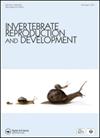海防背景下Lanice conchilega(Polychaeta)体外培养的实际实施
IF 0.8
4区 生物学
Q4 REPRODUCTIVE BIOLOGY
引用次数: 2
摘要
在气候变化和人为压力日益增加的情况下,现有的海岸保护措施越来越不足。生态系统工程师Lanice conchilega (Pallas, 1766)的聚集体稳定了沙质海岸线的沉积物床。因此,这种多毛动物被认为是海岸带管理中寻找自然灵感设计的一个有趣的目标物种。本研究试图通过人工基质培育松果藻,并加强其幼虫的沉降过程,来探讨松果藻作为一种有弹性的海岸建设者的潜力。设计并试验了一种诱导产卵与幼虫饲养相结合的闭式循环水养殖系统。在水温升高之前,有成虫的水箱暴露于不同的光周期。产卵和受精事件记录在0:24亮:暗(LD)的坦克,直到trochophore阶段。实验结果表明,温度冲击诱导产卵法是有效的。本文对松茸体外诱导产卵和幼虫饲养的实践经验进行了讨论和总结,为今后的培养试验提供指导。以浮游生物为样本,进行了海底沉降实验,揭示了人工海底捕获海底幼虫的潜力。尽管如此,还不能排除对基质类型的偏好。本文章由计算机程序翻译,如有差异,请以英文原文为准。
Practical implementation of in vitro culture of Lanice conchilega (Polychaeta) in a coastal defence context
ABSTRACT Current coastal protection measures become increasingly insufficient under circumstances of climate change and increasing anthropogenic pressures. Aggregations of the ecosystem engineer Lanice conchilega (Pallas, 1766) stabilize the sediment bed of sandy shorelines. Therefore, this polychaete is considered an interesting target species in the search for nature-inspired designs in coastal zone management. This study investigated the potential of L. conchilega as a resilient coastal builder by trying to cultivate them and enhancing the larval settling process by using artificial substrata. A closed Recirculating aquaculture system (RAS) combining spawning induction and larval rearing was designed and tested. The tanks with adults were exposed to different photoperiods prior to water temperature rise. A spawning and fertilisation event was recorded in the 0:24 Light:Dark (LD) tank up to the trochophore stage. Additionally, the temperature-shock spawning induction method was experimentally proved effective. All practical experience on the in vitro spawning induction and larval rearing of L. conchilega is discussed and summarized as a guideline for future culturing trials. In vitro substratum settlement experiments with aulophore larvae sampled with plankton hauling revealed the potential of artificial substrata to trap larvae. Nonetheless, a preference in substratum type is not to be excluded yet.
求助全文
通过发布文献求助,成功后即可免费获取论文全文。
去求助
来源期刊
CiteScore
1.90
自引率
0.00%
发文量
21
审稿时长
>12 weeks
期刊介绍:
Invertebrate Reproduction & Development ( IRD) presents original research on the reproductive and developmental biology of the Invertebrata, both embryonic and postembryonic. IRD welcomes papers reporting significant results obtained using new techniques. Encouraged topic areas include: aquaculture, physiology, biochemistry, functional morphology, phylogeny, behavioural and regulatory mechanisms, including genetic, endocrine and molecular studies. Papers containing qualitative descriptions of reproductive cycles and gametogenesis will not be considered. IRD is published in association with the International Society of Invertebrate Reproduction and Development.

 求助内容:
求助内容: 应助结果提醒方式:
应助结果提醒方式:


